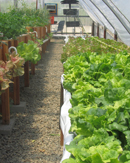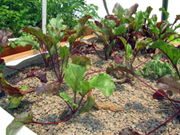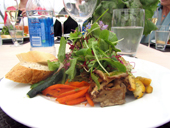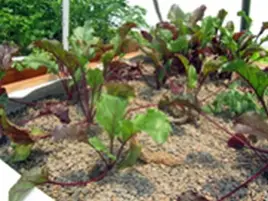A new blend of aquaculture and hydroponic now swims and blossoms in Brea at Future Foods Farms.
BREA, Calif. August, 2012 Eye-opening and state-of-the-art are a few of the words you can use to describe the systems
used to grow salad greens, herbs, vegetables and fish at Future Foods Farms in Brea. “Aquaponics is the most efficient method in the world,” says Adam Navidi, chef, caterer and farmer, about the techniques he uses at Future Foods Farm. The connection between chefs and farmers is well established, but Navidi has gone a step further by becoming both. He not only grows and harvests the food, in a style he engineered himself, but also turns it into delicious meals bursting with just-picked flavor.
Chef Navidi worked high end kitchens around Orange County as a chef before embarking on his own catering business.He always sources products as close to home as possible, knowing that they translate into noticeably better dishes for his guests. Having grown up with fruit trees in the family backyard garden, he became hooked on growing his own produce. Much research and experimentation later, he’s created a system that’s completely sustainable and organic, “I had been playing around with growing food organically, and hydroponically since I was a teenager. Aquaponics is the only way to do both.”
Future Foods Farms’ aquaponic system is uniquely sustainable. It combines hydroponics,growing food in water without soil, and aquaculture, raising fish. Navidi has tanks of tilapia and a few goldfish whose waste water gets pumped to water his crops. The plants absorb the nutrients they need from the water. The tables are set so gravity slowly moves the water back to the fish tanks. Rocks around the plants filter the water while the plants absorb the nutrients and moisture they need as the water runs through their roots.The same water is used over and over, except what’s lost to evaporation.”The plants are getting watered when they want and with what they want, naturally.”
Navidi built his farm with recycled materials on leased oil land that cannot be used for farming due to the soil content. His green houses, purchased used, hold the long, plastic-lined tables with plants and fish tanks.The plants grow in a bed of tree bark and shale rocks (see photo).
His green houses, purchased used, hold the long, plastic-lined tables with plants and fish tanks.The plants grow in a bed of tree bark and shale rocks (see photo).
Other plants are grown in recycled styrofoam boxes, used to ship seafood, modified by Navidi. The boxes are filled with fish-fertilized water and a small hole in the lid allows the plant to grow with roots suspended. He fills them once and is done until harvest.
Organic fish pellets supplement the tilapia’s diet of duckweed and water lettuce, which Navidi grows himself.Beneficial bacteria grow on damp surfaces throughout the system. They convert ammonia from the fish waste into nitrates which feed the plants.
With all the great nutrition it’s no wonder the plants mature about 20% faster than conventionally grown produce. In addition, “We can produce one head of lettuce with one gallon of water. Hydroponics normally requires changing the nutrient/water every 7-10 days which equates to 3-5 gallons of water per head of lettuce. Soil/conventional farming estimates are 10-15 gallons of water per head of lettuce.” The potential for sustainable and profitable agriculture in a state plagued by frequent droughts such as California is unmistakable. “There really is no more efficient farming method in the world,”says Navidi. Countries with recurring droughts and famines could surely benefit from the technique as well.
Not that it’s easy.
Navidi recalls battling weeds as a teenager. Now he fights insects and greedy critters. His methods are eco-friendly; he hangs yellow tape rubbed with molasses to draw the insects away, and sprinkles bird food around for birds and squirrels.
Chef Navadi has not given up his toque for overalls completely. Most of his week is spent farming, “There is more labor involved per sq ft since we are doing everything by hand instead of using tractors and machinery.” On weekends he makes the best possible use of his fresh produce at Farm-to-Table Tour and Tasting dinners in one of greenhouses after guests are given a tour of his farm. He also caters private parties for regular clients who appreciate his seasonal cooking andexquisite produce.
Future Foods Farms’ multi-course farm dinners with corkage, tax and tip are $75. Menus feature just-harvested produce with dishes such as avocado, mango and crab terrine with farm cucumbers, tomatoes and cilantro flowers. Another course might be a salad in olive soil with shaved ruby red beets, rainbow carrots, French radish and wild dill flower vinaigrette. Pan seared tilapia, (of course), with beech mushrooms, pea sprouts and Navadi truffle oil, (by Adam’s brother), with leek and squash blossom risotto.Navadi also serves chicken or salmon on some menus, along with couscous and roasted vegetables make appearances. A recent summer dessert is nectarine terrine with house made cinnamon-basil ice cream topped with farm honey.
with dishes such as avocado, mango and crab terrine with farm cucumbers, tomatoes and cilantro flowers. Another course might be a salad in olive soil with shaved ruby red beets, rainbow carrots, French radish and wild dill flower vinaigrette. Pan seared tilapia, (of course), with beech mushrooms, pea sprouts and Navadi truffle oil, (by Adam’s brother), with leek and squash blossom risotto.Navadi also serves chicken or salmon on some menus, along with couscous and roasted vegetables make appearances. A recent summer dessert is nectarine terrine with house made cinnamon-basil ice cream topped with farm honey.











